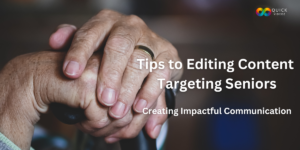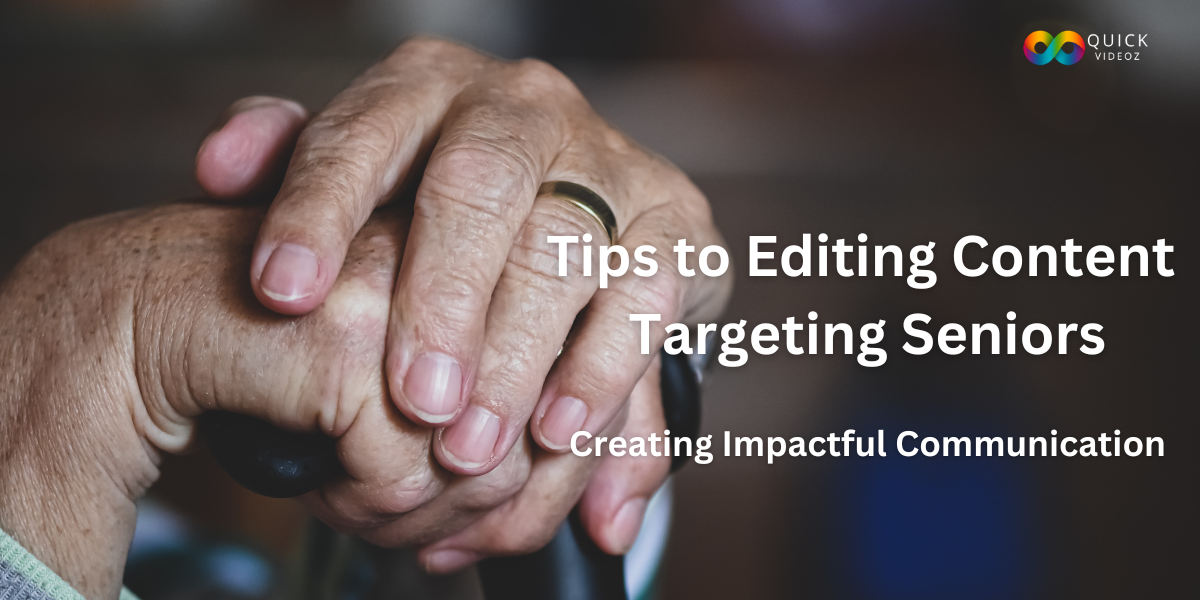
11 Key Factors While Editing Content Targeting Seniors
11 Key Factors While Editing Content Targeting Seniors Editing content requires careful attention to detail and a systematic approach to ensure clarity, coherence, and accuracy.
Editing content requires careful attention to detail and a systematic approach to ensure clarity, coherence, and accuracy. Here are some primary considerations and factors to keep in mind while editing content targeting seniors.

A) Creating memorable content is not as easy as it looks. Editing content is a key step in generating impactful written materials.
B) There are 11 factors recommended
C) Testing & Review – Check for usability when editing content
D) Proofreading & Feedback – To catch any errors
E) Clarity & Conciseness – Creating content that’s easier to understand
F) Consistency – to maintain structure
G) Content Accuracy and Completeness – Cross verifying & validating all facts
H) Grammar and Syntax – Correcting grammatical errors.
I) Visual Elements – Images speak louder than words.
J) Citations and References – Checking all sources are properly cited
K) Accessibility & Inclusivity – Accessible to individuals with disabilities
L) Version Control – To ensure latest information
Legal and Ethical checks – When editing content confirm that it complies with all relevant legal and ethical guidelines
If it’s a technical document, while editing content, ensure a check for usability. This is to ensure the document correctly represents the flow / operation the solution being explained – in a manner that meets user needs, in this case – seniors.. Remember that jargon is painful for most of us, especially seniors. So when editing content targeting seniors keep it simple. Just remember this acronym – K.I.S.S. – Keep It Simple Stupid!
A final proofreading, to catch any errors. Might help to have a fresh pair of eyes (colleagues / subject matter expert) look at it. A continuous feedback loop / process as well for revisions and updates is helpful.
Creating content that’s easy to understand. Avoiding jargon, acronyms and technical terms as much as possible. While editing content targeting seniors, break down long complex sentences into shorter easily readable chunks. Brevity and being concise is a target to be aspired for.
Checking the document for consistent use of style, formatting, terminology, numbering, fonts, citation etc. Also consistency in voice & tone.
Cross verifying & validating all the facts, data and references cited in the document. Ensuring all relevant information required for a complete understanding of the topic at hand is covered while editing content. Also checking if page numbers, references within the document are correct. Hyperlinks as well if it is to be used on the web.
Correcting grammatical errors. Also spelling. Checking for proper use of commas and other punctuation marks.
Images speak louder than words. But misplaced ones are confusing to your senior readers. When editing content, check these for clarity and accuracy. Also that they are properly labeled & referenced within the text.
Checking all sources are properly cited following the required citation style (e.g., APA, MLA, Chicago).
While editing content targeting seniors, ensure that your documents are accessible to individuals with disabilities by following accessibility guidelines. Also, if language and content is inclusive. There are now international legislation & standards covering this. Examples include ADA, ACA (the Canadian equivalent of ADA), WCAG, AODA, Section 508, IS5568.
Generally, there are multiple versions of a document. Using & maintaining version control is useful to avoid errors or confusion.
When editing content confirm that it complies with all relevant legal and ethical guidelines, including copyright and privacy regulations. If the content contains sensitive or confidential information, ensure that proper security measures are in place, including restricted access and encryption. Of course, do be very careful with PHI (Protected Health Information) – especially if you are dealing with healthcare related records of seniors.
By considering these factors and approaching the editing process methodically, you can ensure that your content is well-structured, error-free, and effectively communicate their intended message to the senior audience – in fact everyone.
We found these great articles that might be helpful.

11 Key Factors While Editing Content Targeting Seniors Editing content requires careful attention to detail and a systematic approach to ensure clarity, coherence, and accuracy.

How To Write A Great Explainer Video Script For Seniors Learn how to craft a great explainer video script to sell senior focused products &

How To Make Videos For Social Media To Promote Your Business Alright, folks, let’s dive into the world of social media wizardry! If you’re eager